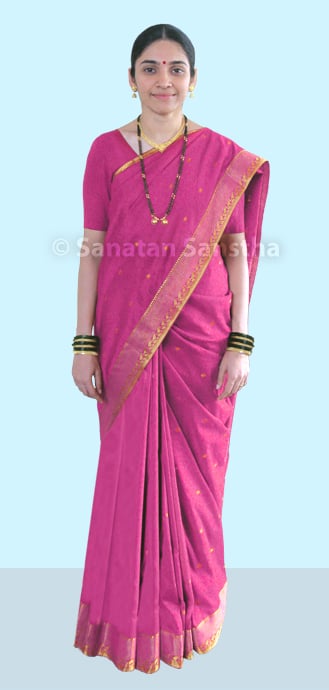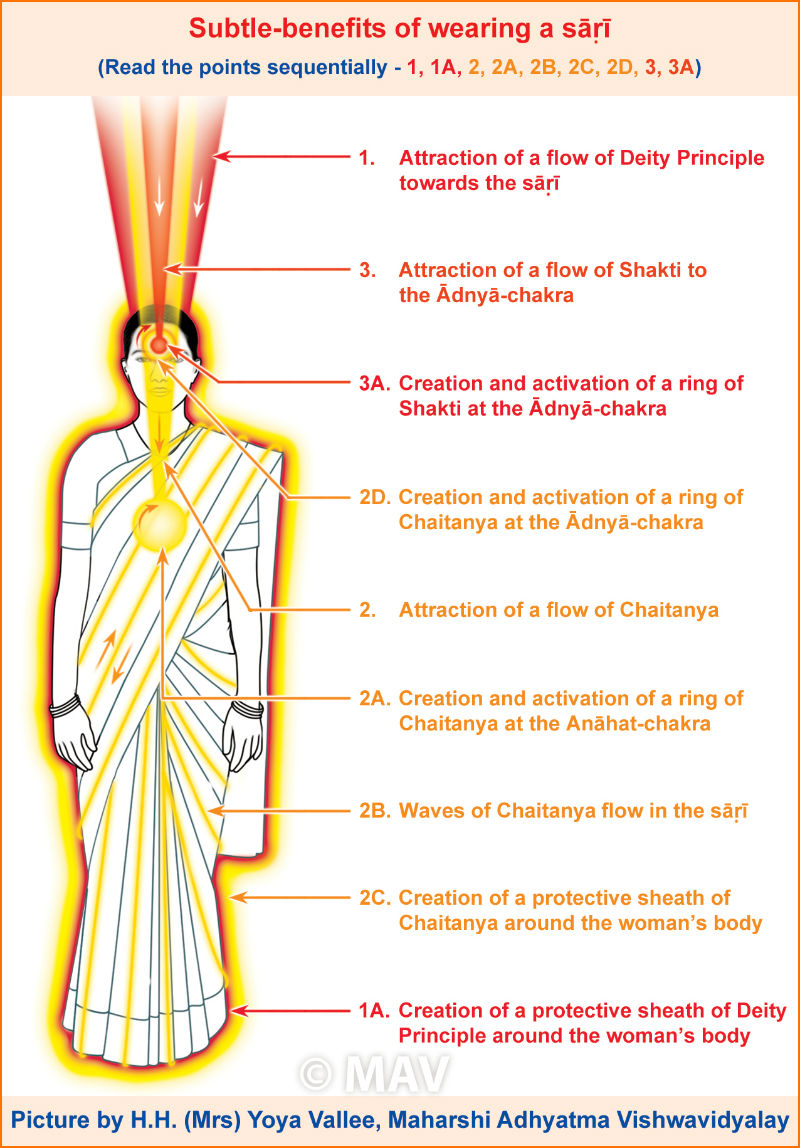1. Introduction
The attire we wear determines the vibrations, emotion and bhav (Spiritual emotion) in us. A Tama predominant attire makes the person extroverted and fickle-minded. Raja predominant attire creates restlessness and agitation in the person. With a Sattva predominant attire the person gains stability of mind and peace.
Sattvik (Sattva predominant) attire such as the Sahavari saree (Six-yard saree), make a woman virtuous and Dharma (Righteousness)-abiding. Abiding by Dharma increases devotion and bhav unto God and the individual begins to move on the path of God-realisation. Since Raja-Tama vibrations are on the rise in the Kaliyug (current era of strife), attire too has become such that its various styles weaken moral values and is inclined towards exhibiting the body. Another disadvantage of wearing rajasik (raja predominant)-tamasik (tama predominant) attire is an increase in the possibility of the distress due to negative energies for the wearer. In contrast, sattvik attire becomes an effective weapon in the battle against negative energies.
The following article includes reports on various experiments that have been conducted by lady-seekers to demonstrate the specific subtle-effect of wearing a Sahavari saree, pictures based on the subtle knowledge related to it and the related spiritual experiences of seekers.
2. Sahavari saree

Given below is a spiritual analysis of the subtle effects of wearing a saree on a seeker.
A. Aspects perceived upon wearing the saree
-
As the act of draping the saree was getting completed, it had a good influence on my mind and I started experiencing a positive change in the state of my mind.
-
On completing the act of wearing the saree, the manifestation of the mantrik reduced and I felt calm after experiencing my own existence.
-
The hot covering of distressing energy that had been created around me was destroyed after wearing the saree and the heat in the body reduced.
-
Pleasant vibrations were experienced at the Anahat-chakra and the mind experienced happiness. This feeling lasted till I wore the saree.
B. Aspects perceived in context with the style of wearing the saree
-
While fixing the pleats or draping the pallu, turn around yourself as you would during a pradakshina (Circumambulation) or start in the clockwise direction, that is, from the left to the right. This will help generate pleasant vibrations. If the pleats are fixed in the converse manner, there is a possibility of generation and congregation of distressing vibrations.
-
If the saree is not tucked in properly, there is a possibility of blockage in the flow of Chaitanya, causing its interruption.
-
If the pleats of a saree are not made properly, the proportion of active Shakti (energy) in the saree
3. Protection of all the Kundalini-chakras from
the Anahatchakra to the Muladhar-chakra upon wearing a saree
-
A protective sheath forms around the Anahat-chakra because of the saree pallu.
-
The saree folds below the waist form a protective sheath around the Muladhar-chakra, Swadhishthan-chakra and Manipur-chakra and protect them from the attacks of negative energies.
4. Subtle-benefits obtained upon wearing a Sahavari saree

A. ‘Proportion of positive Shakti in the picture based on subtle knowledge : 3%
B. Proportion of vibrations : Shakti of Deity Principle 2.5%, Chaitanya 3% and Shakti 2%
C. Other aspects
1. Wearing a saree is a symbol of Hindu Achardharma. Since the action is sattvik, Dharmashaktiis attracted to the woman.
2. This makes her aware of her duty to abide by Dharma in daily life.
3. Spiritual healing takes place on the woman who wears a saree.
4. If a woman who performs spiritual practice wears a saree, she emits Anand, and 1-2% vibrations of Anand are created in the saree.
5. Upon wearing a saree, a woman can experience sattvikta (Spiritual purity) in herself; for example, she becomes aware of her womanhood. Others also feel peaceful, positive and respectful when they look at her.
6. The method of wearing a saree by draping the pallu over the shoulder tucked with a pin and leaving the entire pallu free on the arm without making pleats is not sattvik. This method is illusory and entices others with beauty. It increases the Tama component and ego in the woman.
7. Proportion of sattvikta as per the type of yarn
| Yarn of the saṛi | Sattvikta (%) |
|---|---|
| 1. Silk | 4 |
| 2. Cotton | 2 |
| 3. Synthetic (Polyester) | -1 |
Reference : Sanatan Sanstha’s Holy text ‘Spiritually beneficial clothes for women’


